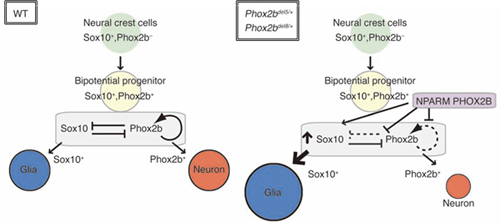| RIKEN Center for Developmental Biology (CDB) 2-2-3 Minatojima minamimachi, Chuo-ku, Kobe 650-0047, Japan |
September 10, 2012 –The neural crest is a transient, mobile population of cells that gives rise to a wide array of cell types, including skeletal, neural, endocrine, and pigment cells, during development, leading some to refer to it as the fourth germ layer. Given its importance, it is not surprising that alterations in neural crest cell migration and differentiation can lead to serious congenital defects, a group of developmental disorders collectively known as neurocristopathies. Most such diseases, which include such common disorders as neuroblastoma and Hirschsprung’s disease, clearly have a genetic basis, but the details of the underlying defect are not well understood. Scientists in the Laboratory for Neuronal Differentiation and Regeneration (Hideki Enomoto, team Leader), led by Mayumi Nagashimada, have now uncovered defects in a specific gene are associated with a group of neurocristopathies of the autonomic nervous system. Published in the Journal of Clinical Investigation, this report shows how mutations in Phox2b perturb the expression of another gene, Sox10, which plays a central role in neural crest development. Nagashimada has since taken a position at the Brain/Liver Interface Medicine Research Center in Kanazawa University.
Interestingly, despite the fact that neuroblastoma is a cancer of the sympathetic nervous system while Hirschsprung’s is a defect in gut innervation, these diseases sometime occur in the same patient. This is particularly the case in patients with a rare condition called central hypoventilation syndrome (CCHS), a respiratory disorder in which breathing often stops during sleep – CCHS patients show a 500 to 1000 times higher incidence of neuroblastoma and Hirschsprung’s disease. Previous genetic studies have shown that a specific mutation in the gene Paired-like homeobox 2b (PHOX2B) is associated with the CCHS-neuroblastoma-Hirschsprung’s triad (CCHS-HSCR-NB). This gene encodes a homeodomain-bearing transcription factor, which itself has been implicated in neural crest development. Of the various mutations known to occur in PHOX2B, many CCHS-HSCR-NB patients exhibit frameshifts affecting the gene’s open reading frame. To study the pathogenic mechanism of such mutations more closely, the team generated mice engineered to carry the same frameshift mutation in Phox2b. The resultant mice proved to be viable for much of development, but showed 100% lethality in the perinatal period. Analyses of heterozygous Phox2b mutant offspring showed they suffered from hypoxia due to failure of spontaneous respiration, and defects in colon innervation and sympathetic ganglion formation – an extraordinarily close match to the symptoms of the CCHS-HSCR-NB association in humans. In mouse, the cells of the autonomic nervous system characteristically express a pair of genes, Phox2b and Sox10; the former in differentiated neurons and the latter in glia. Nagashimada looked at the expression of these genes in two autonomic populations, enteric and sympathetic ganglia, in the mutant animals, and found that Phox2b-expressing cells were markedly reduced in both, while the ratio of Sox10+ cells within the population was dramatically increased. Evidently, the frameshift resulted in a dysregulation of Sox10, freeing it from transcriptional control by Phox2b and resulting in disturbed self-renewal and proliferation of neural progenitors and a bias in differentiation toward glial fate. These imbalances in gene regulation subsequently manifest as the diverse and widespread symptoms observed in the mouse model, and presumably in human CCHS-HSCR-NB patients as well. “This is a very important finding, as we have been able to identify the molecular basis for a developmental pathology of the neural crest,” says Enomoto. “But this is only one of many mutations associated with neurocristopathies such as Hirschprung’s and neuroblastoma, so we hope to continue developing additional mouse models in order to develop a better understanding of and, one day, treatments for these diseases.” |
|||||
|
|||||
|
|||||
 |
| Copyright (C) CENTER FOR DEVELOPMENTAL BIOLOGY All rights reserved. |
